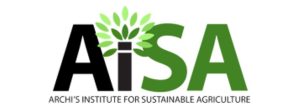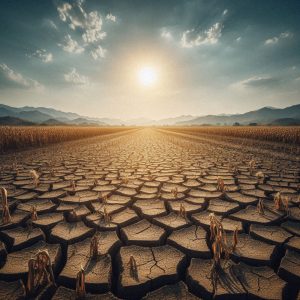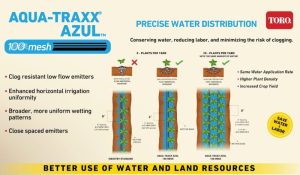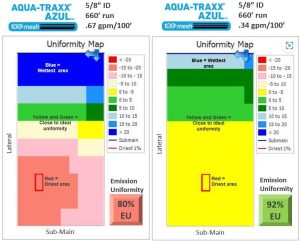Original article by Vegetable Growers News
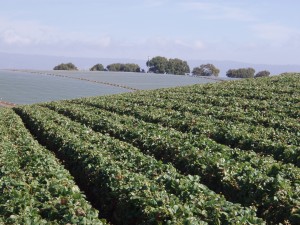 Vegetable growers in Florida are using plasticulture and drip irrigation best practices to improve water and nutrient management on more than 5,000 acres of production. And the effort is paying off, according to one Extension official familiar with the practice.
Vegetable growers in Florida are using plasticulture and drip irrigation best practices to improve water and nutrient management on more than 5,000 acres of production. And the effort is paying off, according to one Extension official familiar with the practice.
Bob Hochmuth, Extension agent for the University of Florida (UF), made a presentation at the Great Lakes Fruit, Vegetable & Farm Market EXPO in Grand Rapids, Michigan that focused on the management of drip Irrigation. He described a process of securing adequate moisture in the root zone without over-filling.
“The increased concern over the impact of agricultural practices on water quality in Florida has resulted in the grower’s need to adopt best management practices (BMPs),” Hochmuth said. “The successful adoption of BMPs in plasticulture production of vegetables in north Florida has been greatly facilitated by Extension programs in conjunction with industry and other agency involvement.
“Growers are more likely to adopt BMPs when they can evaluate them on their own farm,” he said. “Long-term educational program efforts – including hands-on teaching workshops at a research facility combined with on-farm demonstrations – proved to be a very effective strategy in helping vegetable growers using drip irrigation and plasticulture improve water and nutrient management practices.”
Most vegetable growers in the Suwannee Basin region of north Florida are small to mid-sized growers (one to 300 acres), many who have adopted drip irrigation and plastic mulch cultural practices since the late 1980s to produce vegetables such as tomato, bell pepper, eggplant, cucumber, muskmelon and watermelon, Hochmuth said.
Soils in the area are sandy with low water holding capacity (less than10 percent) and low organic matter content (less than 1.5 percent). Due to these conditions, he said, “vegetable production in northeastern Florida requires intense irrigation and fertilization management.
“The recommendations of University of Florida/Institute of Food and Agricultural Sciences (UF/IFAS) for irrigation management for vegetable crops include using a combination of target irrigation volume, a measure of soil moisture to adjust this volume based on crop age and weather conditions, a knowledge of how much water the root zone can hold, and an assessment of how rainfall contributes to replenishing soil moisture.”
Previous educational efforts in northeastern Florida have focused on plant establishment and fertilizer management. The recent development and adoption of statewide BMPs in Florida in rule 5M-8 of the Florida Administrative Code (Florida Department of Agriculture and Consumer Services Office of Ag Water Policy) and the increase in production costs, have emphasized the need for improved irrigation practices and a better understanding of water movement in mulched beds.
Hochmuth said growers’ understanding of the interdependence between fertilization, irrigation and nutrient leaching below the root zone was increased through a targeted effort of on-farm projects.
“UF/IFAS county Extension agents and specialists have been working with Suwannee Valley’s vegetable growers who use plastic mulch and drip irrigation best practices to refine their management of the technology since it was introduced to the region in the late 1980s,” he said. “The emphasis of the educational programs after the turn of the century has been to improve efficiency of water and nutrient management.”
County Extension agents and specialists have coordinated several projects at the regional UF/IFAS Center, Suwannee Valley Agricultural Extension Center, near Live Oak, Florida.
The educational approach was to first demonstrate the new technology at the center through field days and workshops, then followed up by demonstrating that technology on leading growers’ fields throughout the region.
Materials and methods
The initial programs included demonstrating soil moisture sensors such as tensiometers, granular matrix sensors, and time domain reflectometry (TDR) devices, he said. Each can help growers to determine when to irrigate and for how long.
“This program has been taken to dozens of farms in nine counties since the late 1990s,” he said. “The growers learned they were likely to overwater in the first month of the season. Early season overwatering is important to change because they learned the greatest risk of leaching nutrients is during this early season period.
“Growers adopted changes in their early season irrigation management based on the information from these various soil moisture sensors. The remainder of the season water use was changed very little; however, the improved irrigation efficiency early in the season led to reduced fertilizer,” Hochmuth said.
A second specific program to help continue to teach growers water and nutrient management was the initiation of the Florida Drip Irrigation School. The first such school was held at the Suwannee Valley Agricultural Extension Center in 2001 and was so popular it was adopted statewide as a UF/IFAS program and over 25 such schools have been held in Florida since 2001, he said.
The school is an intensive hands-on training for growers to learn to better manage their drip irrigation systems for the delivery of water and fertilizer. Presentations were delivered by university faculty and representatives from the allied industry.
“Over 500 growers have attended these trainings at the Suwannee Valley’s Center and other locations and learned several practices including: using soil moisture sensors, cleaning the system, proper design and maintenance, calculating fertilizer rates, selecting drip tape and determining proper lengths of irrigation events,” he said.
Plant nutrient status can be determined in the field by squeezing plant sap onto Cardy meters that measure either nitrogen or potassium. This gives growers an instant result to guide their fertilizer program week to week. The Cardy meters have been used and demonstrated by several county Extension agents in the area over the last 15 years.
“Most county Extension agents in the Suwannee Valley area of Florida are proficient in petiole sap testing and a few growers and industry representatives have also learned to run this test.” Hochmuth said. “Over 90 percent of the Suwannee Valley watermelon acreage has benefited from this program.”
Research is being conducted to refine petiole sap guidelines for seeded and seedless cultivars separately.
Hochmuth said the educational programs in the Suwannee Valley watermelon growing area have “made a great impact toward adopting BMPs voluntarily. During this long-term effort, 50 growers saw and learn from one or more demonstration on their own farm and they often served as early adopters that helped Extension agents teach other plasticulture growers how to adopt the BMPs.”
As a result, Hochmuth said, growers have:
- Reduced early season irrigation events by more than 50 percent, saving water and reducing nutrient leaching.
- Improved early season irrigation efficiencies, allowing growers to reduce preplant fertilizer rates.
- Reduced preplant nitrogen rates by 20 percent to 50 percent.
Hochmuth said Suwannee Valley watermelon and other vegetable growers using plasticulture techniques have adopted several BMPs including: irrigation sensors, petiole-sap testing, and refining fertilization rates; resulting in adoption of UF/IFAS nutrient recommendations on nearly 90 percent of the area watermelon acreage.
Blue dye tracks moisture movement
Hochmuth described a popular method of managing drip irrigation among Florida vegetable growers. The most recent demonstration being taken to farms is the use of blue dye injected into the irrigation system to see how quickly the water moves downward in the soil in their field, Hochmuth said.
He said the technique has been demonstrated on at least 25 farms from 2004 to 2013 after demonstrations began at the regional UF/IFAS Center, Suwannee Valley Agricultural Extension Center, near Live Oak, Florida in 2001.
The blue dye is used to be able to actually visualize the wetting pattern of the soil profile under the drip tape. After injection of the blue dye, growers followed their normal irrigation schedules for one week and then a cross section of the soil profile under the mulch was dug to measure how far the water and nutrients moved.
The growers showed great interest in using new technology such as moisture sensors and Cardy meters, and seeing the movement of dye on the “digging” visits.
“It was very common for growers to make immediate changes in irrigation schedules, especially irrigation event durations early in the season, based on what they observed,” Hochmuth said. “The greatest challenge in managing the leaching from over irrigation occurred in the early part of the season, weeks one to five after planting.”
He said most growers apply a portion of the total fertilizer program to the soil prior to bedding and mulching. This fertilizer is especially vulnerable to being leached early in the season before the root system and crop become well developed.
“It was shown that single irrigation events of more than one hour in sandy soils can move the blue dye more than a foot deep,” he said. “This can move fertilizer below the root zone, especially in the early part of the season. Many growers have reduced the preplant fertilizer as a result of these programs.”
The blue dye tests conducted on these farms and also at the center near Live Oak, Florida have provided “a very good estimate of movement of the dye in sandy soils. Each grower involved in these demonstrations made adjustments based on the visualization of the movement of the dye.”
Hochmuth said area growers and Extension agents began to coin the phrase, “The blue dye don’t lie,” showing the “undeniable lessons learned in watching the results of the blue dye demonstrations. The changes were immediate, short-term changes to their management. The longer-term changes leading to actual adoption are those make from one year to the next based on these educational experiences.”
The on-farm trials, in addition to other educational programs, such as the Drip Irrigation School and various field days have resulted in significant changes on several farms, Hochmuth said. “Growers involved with the dye demonstrations and other events for three years or more have adopted long-term changes. One of the main changes has come in the fertilizer program by reducing the total nitrogen rate applied prior to bedding and mulching.
“Pre-plant N rate for watermelon has been typically reduced from 100 to150 down to 25 to 50 pounds per acre since the beginning of these programs,” Hochmuth said. “The remaining N is now applied via the drip system over the season.”
He said this part of the fertility program, where fertigation is used, has not dramatically changed over that period of time.
“Therefore, a total reduction of 75 to 100 pounds of N per acre per year has resulted directly from these demonstrations without affecting yield or quality,” he said. “The final resulting N and water management programs on this farm are accepted best management practices for growing watermelon using plasticulture.”

